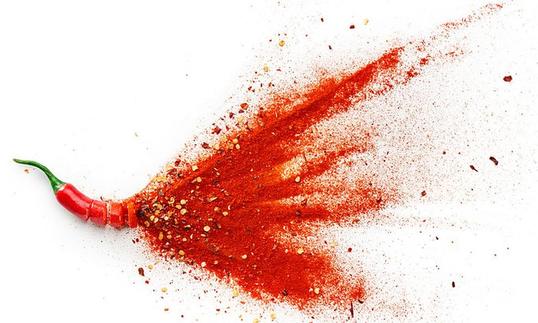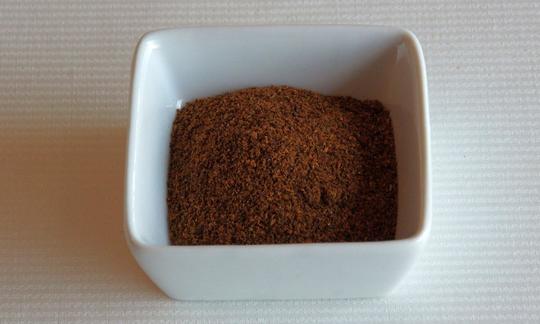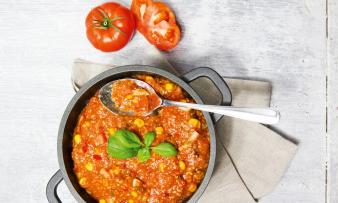Table of contents
Chili powder is a fiery, hot spice mixture for refining different dishes and is considered raw depending on how it is produced. By adding other ingredients, it is possible to reduce the spiciness of the basic ingredient, cayenne pepper . Make sure it is organic quality.
Use in the kitchen
Chili powder is a spice mixture that usually consists of chili varieties such as Aleppo, Ancho, Cayenne (cayenne pepper), Chipotle, Jalapeño or Piri Piri and is usually mixed with cumin , garlic and oregano . In comparison, it is a bit hotter than hot paprika powder , but a bit milder than pure cayenne pepper . It is used to season and spiciness various dishes with meat, fish, tofu, vegetables, for salads, vegan egg dishes and for making marinades. It is particularly popular in Mexican, Spanish and American cuisine. But it is also often used in Indian and Asian dishes. It is an ingredient in various bean stews, burritos, tacos, fajitas, paellas and different pasta dishes - often vegan, such as chili sin carne .
In terms of taste, chili powder actually goes well with almost everything. It goes particularly well with various beans (e.g. kidney beans or black beans ),corn , potatoes , tomatoes , onions , sweet peppers, avocado or other spices such as garlic and oregano. Even more exotic combinations with cinnamon or cocoa powder can be interesting. It is also easy to make yourself and gives free rein to your imagination and combination possibilities.
Is chili powder raw? Unless you reach temperatures above 42°C during the drying process of the pods (either by sun or machine), you can consider chili powder raw. Since this information is difficult to obtain with ready-made products, it is often easier to make the powder yourself.
Making your own chili powder
You can make your own chili powder in just a few steps. The procedure is the same as for paprika powder (hot) , only you use other types of pepper for the ingredients. The basis is usually the cayenne variety. Thin-walled chili varieties are generally best, e.g. "de Arbol" or the particularly hot "Habanero".
Note: The spiciness of chilies is due to the presence of the alkaloid "capsaicin". This secondary plant substance is found mainly in the placenta, the seed pod walls and, in slightly smaller quantities, in the seeds of the pod and cannot be washed off the hands with water. After working with hot chilies, you should rub your hands with vegetable oil or clean them with high-proof alcohol to deactivate the capsaicin. Alternatively, use plastic gloves.
The chili powder is made in five steps:
- Wash the chilies, pat dry, halve or cut into rings. Leave the seeds and plantar tissue depending on the desired level of spiciness. The rule here is: the more you use, the hotter the taste. Use gloves when preparing the chilies or wash your hands thoroughly with vegetable oil or high-proof alcohol afterwards so that the irritating capsaicin does not come into direct contact with the sensitive eyes and mucous membranes.
- Place the chili pieces on a baking tray and dry in the oven (convection) or dehydrator. You can find detailed instructions for the ingredient chili peppers, sun-dried . This process can take several hours. Open the kitchen window for this process. To ensure gentle drying in the oven, dry the chili peppers at temperatures below 50 °C and leave a crack open.
- Once the pieces can be broken, the drying process is complete. When opening the oven, allow the irritating fumes to dissipate before removing the baking tray.
- Finely grind dried, completely cooled chili pieces in a blender or mortar and add 1-2 pinches of salt and dried herbs such as oregano , cumin , garlic granules , cloves or cinnamon depending on the desired taste and grind finely again. Salt also extends the shelf life.
- Sift chili powder as needed and use slightly larger flakes for separate seasoning.
Store finished chili powder in an airtight screw-top jar or spice shaker.
Vegan recipe for bean stew with chili powder
Ingredients (for 4 people): 2 onions , 1 clove of garlic , 400 g kidney beans (cooked) , 210 gblack beans (cooked) , 210 gsweetcorn kernels (canned) , 400 g chopped tomatoes , 1 tbsp chili powder (raw?, organic?), ½ tsp chili flakes , 2 tbsp tomato paste , ¼ tsp cocoa powder , 1 tsp salt , 2 tbsp fresh coriander (torn), 1 tbsp rapeseed oil (refined) .
Preparation: Peel and finely chop the onion and garlic. Put the rapeseed oil in a pan and sauté the onion and garlic. Mix in the tomato paste, chili powder and chili flakes. Meanwhile, rinse the kidney beans, black beans and corn and drain. Add together with the chopped tomatoes and cocoa. Season with salt. Serve the vegan bean stew in plates and garnish with coriander.
Vegan recipes with chili powder can be found under the note: " Recipes that have the most of this ingredient ".
| Not only vegans or vegetarians should read this: Vegans often eat unhealthily. Avoidable nutritional mistakes . |
Purchasing - Storage
Chili powder is available all year round from major retailers such as Coop , Migros , Denner , Volg , Spar , Aldi , Lidl , Rewe , Edeka , Hofer , Billa and in organic quality from organic supermarkets such as Denn's Biomarkt and Alnatura . Other good places to buy it are health food stores and delicatessens or online retailers.
The availability of chili powder varies depending on the size of the store, catchment area, etc. Our recorded food prices for the DA-CH countries can be found above under the ingredient image - and by clicking you can see their development at various suppliers.
Storage tips
It is best to store the powder tightly closed in a dark, cool and dry place, otherwise the spiciness can quickly evaporate. If the powder contains a high herb content, use it as soon as possible.
Ingredients - Nutritional values - Calories
Here we realistically show you the ingredients of spices and herbs per 1 g (instead of per 100 g as usual).
1 g of chili powder provides 2.82 kcal of energy. This includes 0.14 g of fat, 0.50 g of carbohydrates and 0.13 g of protein. As a spice mixture, the amount of table salt it contains should be noted, which at 72.82 mg/1g covers 3% of the daily requirement. Of this, 28.67 mg is sodium. 1 The composition can vary greatly, which is why these nutrients are an example:
Vitamin E , vitamin A and pyridoxine (vitamin B 6 ) are the most important essential nutrients that chili powder offers. However, because of the small amount consumed, they and the macronutrients do not contribute significantly to covering the respective daily requirement. Far more important for the health value are the secondary plant substances in this ingredient, which can have an effect even in trace amounts. Although all herbs and spices have many health-promoting ingredients, we deliberately avoid the insubstantial buzzword superfood here.
A study of 14 different types of chili peppers showed that the samples are a rich source of secondary plant substances with antioxidant and antidiabetic effects. These include phenolic compounds, carotenoids, flavonoids and capsaicinoids. 2
You can find the complete ingredients of chili powder, the coverage of the daily requirement and comparison values with other ingredients in our nutrient tables. In the article Nutrients explained you will get a detailed insight into the topic.
Health effects
Is chili powder healthy? Dried chili peppers have a number of health benefits. In addition to important vitamins such as vitamin C and E, the secondary plant substance capsaicin in particular has numerous positive effects. This belongs to the group of capsaicinoids, which have antibacterial and fungicidal properties. 3
Research has extensively examined capsaicin and its biological effects. These include cardio-protective, anti-lithogenic (kidney stone prevention), heat-generating, anti-inflammatory and analgesic properties, as well as positive effects on the gastrointestinal system. Capsaicinoids therefore have potential clinical value for pain relief, cancer prevention and weight loss. 4 It should be noted that many of the results come from animal studies that require further clinical studies. Detailed information can be found in the article on cayenne pepper .
Dried red chili peppers and the chili powder made from them are also rich in carotenoids. Capsanthin, capsorubin and lutein are responsible for the red colour of the pods and powder, have an antioxidant effect and can protect against UV light. 5
Dangers - Intolerances - Side effects
A rare allergy to nightshade plants can provoke an allergic reaction or intolerance to chili powder. The allergy spectrum is very individual and can change over time. 6 In addition, the development of cross allergies is also possible, e.g. based on existing allergies to birch pollen, grass pollen, cereal pollen or mugwort pollen. 6,7
Along withblack pepper , cumin , turmeric , oregano and saffron , chili powder is extremely vulnerable to fraud and food adulteration. An analysis of 1,885 samples of six different herbs and spices carried out in 2021 by the Joint Research Center ( JRC ), commissioned by the EU Commission , classified 6% of the chili powders examined as being at risk of adulteration. The fraudulent measures included the use of ingredients, additives, colorants or other components that are not approved for use in food and/or herbs and spices, or are approved but not declared. Or valuable components have been omitted. Unauthorised dyes were found in 10 of the 27 suspect samples, five samples had a total ash content of more than 10% and the remaining suspect samples contained undeclared plant species. In most cases these were maize ( Zea mays ), carrot ( Daucus carota ), tomato ( Solanum lycopersicum ), sunflower seeds ( Helianthus annuus ) and onion or garlic species ( Allium spp.). 8
Higher doses of capsaicin can lead to mucous membrane irritation, nausea, vomiting or high blood pressure. Children in particular can suffer serious poisoning more quickly. However, the German Federal Institute for Risk Assessment states that no health disadvantages are to be expected within the scope of internationally usual consumption. 9
Ecological footprint - animal welfare
The footprint of a food depends on various factors. The type of agricultural production (conventional vs. organic), seasonal, regional or domestic production or import by truck, ship or plane, different types of packaging and whether the goods are fresh or frozen all play a decisive role. 10
Chili powder is calculated with a CO 2 footprint of 5.2 kg CO 2 eq/kg, although this value can vary depending on the manufacturer. 11
Despite intensive research, we have not yet been able to determine the water footprint for producing 1 kg of chili powder. However, dried chilies have a high water consumption of 7365 l/kg. 17 The following applies: Fresh, unpackaged, seasonal and regional vegetables have the lowest emissions. The more a product is processed, the greater its environmental impact is as a rule.
Detailed explanations of various sustainability indicators (such as ecological footprint, CO2 footprint, water footprint) can be found here .
Worldwide occurrence - cultivation
Since chili powder is a spice mixture, usually made up of cayenne pepper and oregano , you can find information on the cultivation of these two ingredients directly in the linked article.
Chili powder is now consumed worldwide. India, followed by China, Pakistan and Bangladesh, accounts for almost 55% of the total global chili production. In North America, experts expect the chili powder market to grow significantly due to the increasing trend towards cross-cultural foods, the growing consumer preference for spicy and Asian dishes and an increasing willingness to experiment with different spices and flavors. Changing taste preferences and growing interest in authentic and new chili flavors have also driven the European market. Germany, Spain and the United Kingdom are characterized by the highest chili powder consumption. 12
Industrial production
Industrial production can vary depending on the producer, the ingredients used and the amount produced per hour. The traditional production of ground chili basically involves the following steps: harvesting the fruit, rough cleaning, drying (usually sun drying), sorting, dry cleaning, removing the stems, chopping and grinding the pods into powder, sieving the powder, packaging and distribution. 13 The drying of chili peppers and other spices can also be done mechanically. The production of spice mixtures only takes place after the entire drying process, as each spice has individual drying requirements and the mixing techniques are also based on their own recipes.
Further information
The chili varieties used to make chili powder belong to the genus Capsicum , the nightshade family (Solanaceae). According to current information, there are 35 wild and 5 domesticated species ( Capsicum annuum , C. frutescens , C. chinense , C. baccatum and C. pubescens ). 14
The degree of spiciness is measured in so-called Scoville units, whereby the division on the Scoville scale depends on the capsaicin contained. Spiciness is generally divided into mild (0-700 Scoville units), spicy (700-3000 Scoville units, e.g. sambal-Tabasco sauce), medium hot (3000-25,000 Scoville units, e.g. jalapeño ), hot (25,000-70,000 Scoville units, e.g. serrano or cayenne pepper) and very hot (over 80,000 Scoville units, e.g. habanero). Pure capsaicin has a value of 15-16 million Scoville units. However, there are types of pepper, such as the chili hybrid "Carolina Reaper", whose Scoville units even break the 2 million mark. 15 Since chili powder mostly consists of cayenne pepper, it is classified in the "hot" category.
The story of the invention of chili powder is disputed. Some chili historians attribute the invention of the red powder to DeWitt Clinton Pendery of Fort Worth, who began selling his own brand of "Chiltomaline" to cafes and hotels in the early 1890s. It was Pendery who pointed out in his advertising: The health-giving properties of hot chili peppers are unmatched. They invigorate the digestive tract, regulate functions, give a natural appetite and promote the healthy function of the kidneys, skin and lymphatic vessels. Pendery's company, initially called The Mexican Chilley Supply Company , later changed its name to Pendery's and still operates in Fort Worth today, selling chili powder (and many other spices). Other sources claim that it was William Gebhardt of New Braunfels, Texas, who produced the first packaged chili powder in 1894. At first he called the product "Tampico Dust", later he changed the name to "Gebhardt's Eagle Chili Powder", which still exists today. 16
Alternative names
In American English, chili powder is called "chili powder", whereas in British English "chilli" is written with two "l's".













Comments